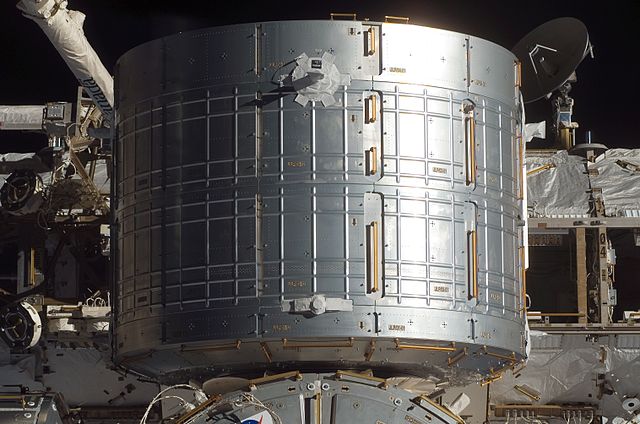Japanese ISS module, used on ISS press conferences From Wikipedia, the free encyclopedia
Kibō (Japanese: きぼう, lit. 'Hope'), also known as the Japanese Experiment Module (JEM), is a Japanese science module for the International Space Station (ISS) developed by JAXA. It is the largest single ISS module, and is attached to the Harmony module. The first two pieces of the module were launched on Space Shuttle missions STS-123 and STS-124. The third and final components were launched on STS-127.[1]
 Kibō showing its main pressurized module, logistics module, exposed facility, and robotic arm, as seen by Space Shuttle Endeavour on STS-134 | |
| Module statistics | |
|---|---|
| Part of | International Space Station |
| Launch date |
|
| Launch vehicle | Space Shuttle Endeavour and Discovery |
| Berthed | 14 March 2008 (Harmony port) |
| Mass | 24,200 kg (53,400 lb) |
| Length |
|
| Diameter | 4.4 m (14 ft) |
| Configuration | |
 | |
In initial configuration, Kibō consisted of six major elements:[2]

The Pressurized Module (PM) is the core component connected to the port hatch of Harmony. It is cylindrical in shape and contains twenty-three International Standard Payload Racks (ISPRs), ten of which are dedicated to science experiments while the remaining thirteen are dedicated to Kibō's systems and storage.[4] The racks are placed in a 6-6-6-5 format along the four walls of the module. The end of the PM has an airlock and two window hatches. The exposed facility, experiment logistics module, and remote manipulator system all connect to the PM. It is the location for many of the press conferences that take place on board the station.

The Exposed Facility (EF), also known as "Terrace", is located outside the port cone of the PM (which is equipped with an airlock). The EF has twelve Exposed Facility Unit (EFU) ports which attach to Payload Interface Unit (PIU) connectors on EF-equipment exchange units (EF-EEUs). All experiment payloads are fully exposed to the space environment. For proper functioning of these experiments, the payload requires an orbital replacement unit (ORU), consisting of the electrical power system (EPS), communications and tracking (CT), and the thermal control system (TCS). Of the twelve ORUs, eight are replaceable by the JEMRMS while the other four are EVA-replaceable.

The experiment logistics module (ELM) includes two sections:
The JEM remote manipulator system (JEMRMS) is a 10 m (33 ft) robotic arm, mounted at the port cone of the PM. It is used for servicing the EF and for moving equipment to and from the ELM. The JEMRMS control console was launched while inside the ELM-PS, and the main arm was launched with the PM. The small fine arm, which is 2 m (6 ft 7 in) long and attaches to the end effector of the main arm, was launched aboard HTV-1 on the maiden flight of the HTV spacecraft. Once HTV had docked, the small fine arm was assembled by the crew and deployed outside the airlock to test it. The JEMRMS grappled the arm and unfolded it to flex the joints before stowing it onto the EF.[8] The free end of the JEMRMS is able to use the same type of grapple fixtures that the Canadarm2 uses.[9]
Inter-orbit Communication System (ICS) consists of a rack of communication module in the Pressurized Module (ICS-PM) and the antenna module to be attached on the Exposed Facility (ICS-EF).[10] It was used to communicate with the ground station via JAXA's communication technology demonstration satellite DRTS "Kodama". After the decommissioning of DRTS in August 2017, Kibō relies on the ISS's Ku band communication through NASA's TDRSS. ICS-EF was disposed by jettisoning into orbit in February 2020[11] and reentered on March 17, 2023[12] over Sacramento, California.[13]
NASA launched the JEM complex over three flights using the Space Shuttle. The shuttle had a large payload bay which carried the modules into orbit along with the crew. This is in contrast to the Russian modules, which are launched into orbit on multistage Proton rockets and then rendezvous and dock with the station automatically.
On 12 March 2007, the Experiment Logistics Module-Pressurized Section (ELM-PS) arrived at the Kennedy Space Center (KSC) from Japan.[14] It was stored in the Space Station Processing Facility (SSPF) until launched into orbit aboard Endeavour on 11 March 2008 as part of the STS-123 mission.[15]
On 30 May 2003, the Pressurized Module (PM), the main laboratory, arrived at KSC from Japan.[16] It was stored at the SSPF until launched into orbit aboard Discovery on 31 May 2008 as part of the STS-124 mission.[17] On 3 June 2008, the PM was attached to the Harmony module. At first the ELM-PS, the small cargo bay, was connected to a temporary location on Harmony and later, on 6 June 2008, was moved to its final berthing location on top (zenith) of the main laboratory.
The Exposed Facility (EF) and Experiment Logistics Module-External Section (ELM-ES) arrived at KSC on 24 September 2008.[18] The two elements were launched on Endeavour on 15 July 2009 as part of the STS-127 mission.[19] The ELM-ES was brought back to Earth at the end of the mission. The assembly of the EF was completed during the fifth spacewalk of the mission.[20]


Kibō is the largest single ISS module:

The module and all its integrated accessories were manufactured at the Tsukuba Space Center in Japan. It is made from stainless steel, titanium, and aluminum.


Source:[26]
Deorbited with Kounotori 5 (HTV-5):
Deorbited with SpaceX CRS-15:
Deorbited with SpaceX CRS-17:
Jettisoned into orbit by ISS robotic arm:[44][45]
Japanese:
American:
This section needs expansion. You can help by adding to it. (August 2020) |
Seamless Wikipedia browsing. On steroids.